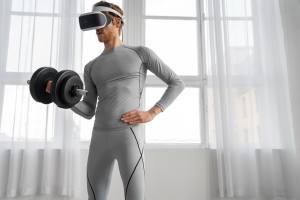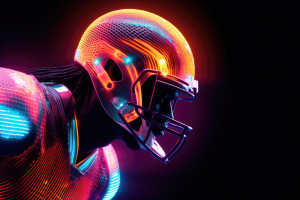In stadiums roaring with fans and locker rooms pulsing with tension, there’s an invisible force transforming the world of sports: artificial intelligence. No longer confined to science labs and Silicon Valley startups, AI is now embedded in locker rooms, coaching decisions, and even fan experiences. It’s changing the game — literally.
From fine-tuning player performance to forecasting match outcomes with startling accuracy, AI has become a powerful tool embraced by teams, leagues, and tech-savvy fans alike.
The Data Game: Where AI Dominates
The essential need for AI is data input, while sports events create a massive quantity of statistical information. Each on-field passing movement, together with sprinting action, tries at goal, and player changes, leaves valuable information behind. AI technology instantly processes huge amounts of data to identify configurations surpassing human observational capabilities.
Even betting platforms like Melbet have integrated AI-driven analytics to offer more intelligent, predictive sports engagement. The sports world is amid a quiet revolution where data, not just muscle, drives the scoreboard.
The professional soccer game benefits from both camera systems and GPS trackers which track each player’s movements accurately to within a single centimeter. Positional data processing by algorithms allows the identification of strategies that maximize goal opportunities. Heat maps alongside pressure metrics receive direct delivery to coaches at the same time as predictive models which helps them implement quick tactical changes.
The NFL runs predictions for injury hazards through AI systems while AI examines video database frames to generate tactical plans based on identified opponent patterns. Catapult and Zebra Technologies, along with other AI-driven platforms, serve as fundamental tools for coaches by enabling them to plan intelligently instead of simply increasing the intensity of their work.
Team sports represent only part of the applications of AI technology. Tennis events implement artificial intelligence to examine swing speed alongside hitting angle and ball rotation, which produces instant performance assessments for players. The technology goes beyond observation because it uses its acquired knowledge to provide recommendations.
Smarter Training Through Technology
AI affects more than just game day. In fact, some of the most important work is done away from prying eyes behind closed gym doors.
Wearable devices powered by AI analyze biometric and skeletal movement data to create customized training regimens. These programs are modified as needed based on fatigue level, recovery rate, and even sleep cycle. This minimizes the chances of injuries, promotes better quality of performance, and helps sustain athletes over time.
ML models assist in overtraining detection even before symptoms develop, a development vital in sports where repetitive stress and bad GOTO intervals can hamstring a career.
Coaches have also transitioned into the world of data science. Each athlete’s performance decay is depicted on personalized dashboards, so ‘gut decisions’ are a thing of the past. AI is not just about working hard; its relevance can be summarized as working smart.
How AI is used in different sports:
| Sport | AI Application |
| Football (Soccer) | Tactical analysis, player tracking |
| Basketball | Shot prediction, injury prevention |
| Tennis | Swing analysis, real-time performance stats |
| NFL | Play simulations, concussion detection |
| Cricket | Ball trajectory modeling, player fatigue tracking |

The Fan Experience Reimagined
AI not only plays a fundamental role in how games are played, but it has also directly impacted the ways in which fans watch sports on television or engage with them online.
Thanks to AI, personalization options are now available to fans for generated clips that highlight specific players and include unique angles or specialized views. With VR technologies, AI allows fans to live historical matches from the “field” perspective. At the same time, broadcasters are applying AI for predictive analysis of live events to enhance context during primary coverage which subsequently improves how events are watched.
AI technology has also improved fantasy leagues. From set up to trades, passes and offers players make are powered by AI algorithms that make decisions based on player conditions, match chances and even weather. The integration of AI technologies makes sports more entertaining and informative for fans in an unprecedented way, and this is just the beginning.
Betting Smarter with AI
The advancement of AI has affected everything including the betting industry with additional complexity and responsibility. The outcomes of sports betting can now be predicted with predictive algorithms and complex historical data analysis, effectively turning the gamble into a science.
AI is now used to control gambling excesses. Given abnormal betting patterns, gambling psychopathology can be flagged along with other safeguards.
Social platforms like Melbet Facebook BD also harness AI to engage users with live data, trend analyses, and AI-generated match previews. It’s no longer just about odds — it’s about informed, intelligent participation.
Real-World Success Stories
Sports teams and organizations all over the world are making use of AI technology and reaping the benefits. AI scouting tools help clubs in European football identify aspiring superstars who are hidden in deep player metrics. Even lesser funded teams which previously found it difficult to compete are able to do so because of AI enabled platforms.
Slower-developing countries are also starting to catch up. Teams in the Indian Premier League utilize AI to replicate pitch conditions, while Olympic committees in Asia and Africa are establishing sports tech incubators to infuse AI into their training programs. The revolution is global, increasing, and cannot be stopped!
The Future Is Now
On a larger scale, AI is changing sports as we know them. The numbers, the pixels, and the sensors all herald a new era in sports. For fans, this results in deeper engagement and better outcomes. For competitors, it translates to more informed decisions, and to the industry, it leads to smarter analyses. However, this is just scratching the surface of what lies ahead globally.
In terms of technological advancement, where does the intersection of human intelligence and AI reign? Intuition and brute force alone do not decide the future of sports. Data fabrication and algorithms will always trump athletic prowess by having full control over the outcome, an outcome that is significantly morphing.

